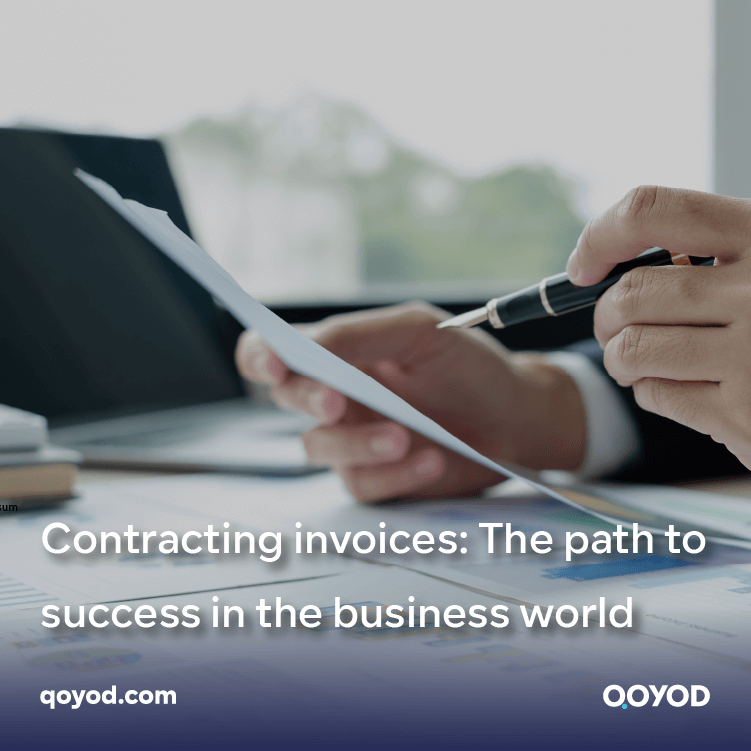Despite the economic challenges and financial pressures facing many businesses in the modern era, contracting invoices is a vital tool that helps organisations achieve success and prosperity. In a world full of rapid changes and fierce competition, this invoice represents a means of tracking project financial performance and a gateway to operational effectiveness and efficiency. So in this article, we will explore how contracting invoices can be the golden key that opens the doors of new opportunities, turns challenges into tangible achievements, and enhances confidence between project owners and their clients. So join us on an exciting journey to discover the secrets of this ingenious financial tool and how to prepare it for long-term success in the contracting sector.
What does a contracting invoice signify?
Also known as work payment statements, they are financial documents issued periodically during the project implementation stages. These documents include details of the executed work, which helps to organise and follow up on financial payments between the owner and the contractor.
Describe the extract as a cumulative document.
We always refer to extracts as a ‘cumulative document’, reflecting their nature as they contain details of all the work completed up to the submission date. Therefore, each new extract builds on the previous extracts, incorporating the terms and entitlements of previous payments, until it reaches the final extract, which encompasses all the project’s work.
It is worth noting that this accumulation of extracts does not imply repaying previously paid amounts; rather, it aims to document all project stages comprehensively.
Mechanisms for issuing extracts
Contracting invoices are issued either at equal intervals or based on specific project steps that have been agreed upon in advance under what is known as ‘milestones.’
The contracting invoice includes tables that include business items, clarifying their unit of measurement, quantity, and the percentage of disbursement due for each item. The consultant’s role is pivotal here, as he is responsible for reviewing and following up on these items to ensure the contractor’s accuracy and credibility in submitting the extracts.
The documentary importance of the extracts
Extracts serve as an accurate documentary record of all completed work and payments, facilitating project follow-up, ensuring transparency between the owner and contractor, preventing financial disputes, and guaranteeing the project’s implementation in accordance with the agreed-upon schedule and specifications.
Payments made in extracts and their importance
“Advance payments” is one of the important elements in managing contracting extracts. These payments are sums of money provided by the owner to the contractor before starting work, and they are often 10% of the total contract value and may sometimes reach 25%.
We issue these payments to assist the contractor in securing the cash required to begin work, which we later recover through periodic extract deductions.
Notice
In exchange for the advance payment, the contractor issues a letter of guarantee to ensure the owner’s rights. This letter guarantees the owner a refund of the advance amount if the contractor breaches his obligations. The owner can liquidate the letter and recover his money if he decides to stop working with the contractor.
What are the types of contracting invoices?
Knowing the different types of contracting invoices, their purposes, and timings is necessary to ensure efficient project management and achieve a financial balance between the various parties. This can be summarized as follows:
technical invoices
Current contracting invoice
- Purpose: Follow up and periodically document the progress of the project.
- Timing: Submitted after each work has been completed within the agreed timeline.
- Mechanism: The contractor submits an invoice to the owner and receives an agreed-upon percentage of its value (usually at most 95%).
- 5% remains a guarantee, to be paid after the inspection and initial delivery.
final contracting invoice
- Purpose: Documentation and settlement of work after complete completion of the project.
- Timing: To be submitted after all preliminary work and handover have been completed.
- Contents: This includes all documents and copies of current invoices intended for the final settlement of accounts with the owner.
Executive contracting invoice
- Purpose: An internal report used to document the business in detail.
- Timing: Periodic throughout the project.
- Mechanism: This type is not provided to the owner but is used internally within the contracting company to monitor progress and ensure quality.
Administrative invoices
Owner invoice
- Purpose: Requesting the disbursement of funds from the owner to the contracting company.
- Timing: Issued by the technical office of the contracting company and addressed to the owner when payment is needed.
- Contents: It includes the completed works and the amounts due and helps facilitate financial transactions between the contractor and the owner.
Subcontractor invoice
- Purpose: Settlement of subcontractors’ dues (such as the drilling or plumbing contractor).
- Timing: Issued when the contracting company has to pay subcontractors.
- Mechanism: It is prepared by the technical office of the contracting company, and the consultant or owner does not participate in this process.
Uncommon extract types
Expected final invoice
- Purpose: To estimate the total cost of the project before completion.
- Timing: Issued when the owner wants to know the expected cost of the project before its actual completion.
- Mechanism: Used for financial planning and managing budget forecasts.
Stop invoice
- Purpose: Documenting the work carried out and evaluating what remains after the project is withdrawn from the company.
- Timing: Issued in the event that the project is withdrawn from the main contractor.
- Contents: Defines what has been accomplished and what the replacement company should do.
Steps for preparing a contract invoice
Consultant role
The consultant is the owner’s supervisory eye on the project, and his responsibility is to ensure the quality of the work carried out. Therefore, before preparing a contracting invoice, you must ensure that the consultant is informed of and approves of all the completed work. Sometimes, the consultant issues an official letter confirming his inspection of the work.
Preparing basic documents
A set of necessary documents must be prepared, which include the following:
- A detailed survey includes the business items on which the invoice will be prepared.
- Assignment Order: A document assigning the contractor to carry out the work.
- Site receipt report: confirms the contractor’s receipt of the site.
- The time and financing program determines the dates for implementation of the works and the payment schedule.
Collect technical and financial information.
- Technical designs: all necessary drawings that show details of the work.
- Budget: Estimate the total cost of the project.
- A comprehensive inventory of the site includes all items of work carried out up to the date of preparing the contracting invoice.
Inspection and implementation of works
What has been implemented on the ground is reviewed from an engineering perspective, and the quantities implemented up to the date of the invoice are recorded and recorded accurately.
Calculate quantities and prices.
Pricing inventory: The price of each unit used in the business is written.
Calculating the total: Multiply the quantity of each unit by its price to get the total value for each item.
Estimating exchange rates
The percentage that the contractor is entitled to from the total value of the contracting invoice must be estimated, as the entire amount is not paid in one go but rather an agreed-upon percentage is disbursed, and it is worth noting that this also includes deducting the necessary deductions.
deducting previous invoices
The value of previously paid invoices is deducted from the value of the current contract invoice to determine the final amount that will be paid to the contractor after applying the discount rates.
Invoice cover
The cover includes the basic data of the project:
- project name.
- invoice number.
- Owner’s (client) name.
- Title and name of the consultant.
- Name of the contracting company or contractor.
An example of contracting invoices
An invoice is a document in which all the work completed by the contractor on a specific project is recorded, indicating the quantities executed, units, and prices. Here is a simplified example to help you understand it more clearly:
Residential building construction project
Project details
- Project name: construction of a residential building.
- Client: Real estate development company.
- Contractor: Advanced Construction Company.
- Project duration: 12 months.
- Start date: January 1, 2023 AD.
- Completion: December 31, 2023 AD.
Extract items
| Item No | Description Item | Unit | Quantity implemented | unit price | Total cost |
| 1 | Foundation digging | m³ | 500 | 50 riyals | 25,000 riyals |
| 2 | Pouring concrete for foundations | m³ | 300 | 70 riyals | 21,000 riyals |
| 3 | Building walls | m² | 1000 | 30 riyals | 30,000 |
| 4 | Installation of concrete columns | number | 50 | 200 riyals | 10,000 riyals |
| 5 | Extension of the electricity network | M | 200 | 15 riyals | 3,000 Saudi riyals |
| 6 | Extension of the water network | M | 150 | 20 Saudi riyals | 3,000 riyals |
| 7 | Installation of doors and windows | number | 100 | 80 riyals | 8,000 riyals |
| 8 | Painting and finishing works | m² | 1500 | 10 Saudi riyals | 15,000 Saudi riyals |
Financial summary
Total cost of implemented items: 115,000 Saudi riyals.
Tax (15%): 17,250 Saudi riyals.
Total after tax: 132,250 Saudi riyals.
How does Qoyod help you create a contracting invoice Excel form?
Real estate and contracting management is one of the processes that requires high precision and organization to ensure that business runs smoothly and achieves the desired results. To achieve this goal, the Qoyod website provides an effective tool that helps you create a contracting invoice Excel model efficiently and accurately. Here is how it can be done:
Providing project data
The Qoyod program allows you to access updated and comprehensive data about the projects you are working on, as the program can provide accurate details that include the scope of work, completion dates, and the various stages of the project, in addition to the work that has been completed.
It is worth noting that this basic information is the cornerstone of preparing the contracting invoice form, as it helps you track progress and provide accurate reports.
Providing cost data
The Qoyod program provides detailed information about the costs associated with each stage of the project, including labor costs, materials, equipment, and any additional costs that may arise.
It is worth noting that with this accurate data, you can prepare a contracting invoice model in Excel that reflects the real costs. This helps avoid errors and achieve transparency with clients and financiers.
Update information easily.
The Qoyod program features seamless integration with Excel files. This integration makes it easier to update information without having to manually enter data, and updated data is always at your fingertips. This reduces the time and effort needed to prepare the model, as you can simply import new or modified data directly into the Excel model with the click of a button.
Customise data and reports.
Qoyod gives you the flexibility to customise data and create detailed reports according to your needs. You can use the data provided to design a contracting invoice model that precisely fits your project requirements. Thanks to this customization, you can produce professional and comprehensive reports that help you communicate clearly with stakeholders and provide a complete picture of the project’s progress.
Contracting invoice form
If you want to download the contracting invoice form, all you have to do is click here.
Conclusion
Contracting invoices are of great importance in the field of construction projects and contracting activities, as they are the main means of organising the flow of financial payments between the parties to the process and determining the volume of work completed on a regular basis. It also provides great transparency in financial transactions, facilitates the accounting and control process over project implementation, and through work extracts, the owner is able to accurately follow up and evaluate the contractor’s performance, as these extracts include full details of the activities carried out, and the quantities and prices agreed upon. This helps in discovering any possible deviations or violations during implementation. It also shows the percentage of completion of the project and facilitates the process of issuing interim and final certificates upon completion of the work.
Contracting invoices are the basic tool for entitlement to agreed-upon financial payments, and it is worth noting that the Qoyod program helps you in this regard, as it provides you with a point-of-sale system, electronic invoice systems, etc. at unparalleled prices, which makes it an integrated accounting program.
After knowing what contracting extract is and its types, try Qoyod now for free for 14 days. It is an accounting program that will save you time and effort.
Join our inspiring community! Subscribe to our LinkedIn page and Twitter to be the first to know about the latest articles and updates. An opportunity for learning and development in the world of accounting and finance. Don’t miss out, join us today!




